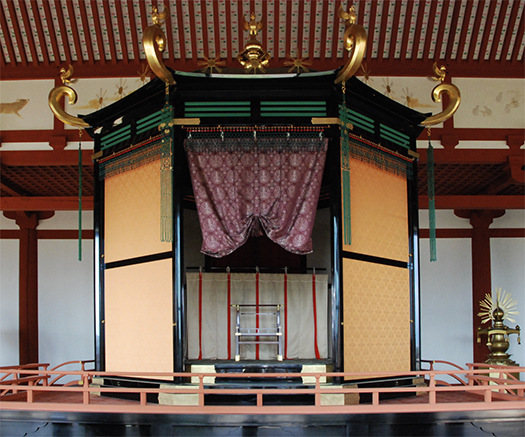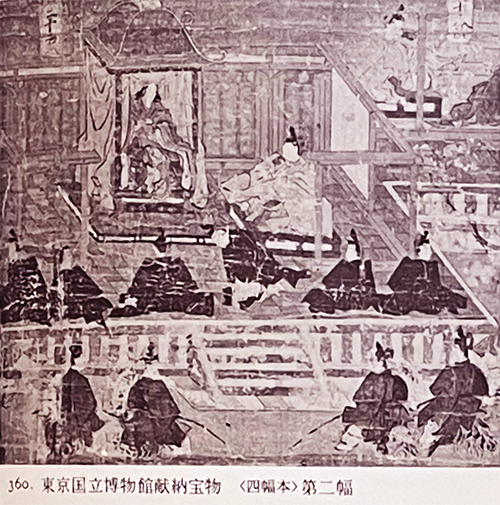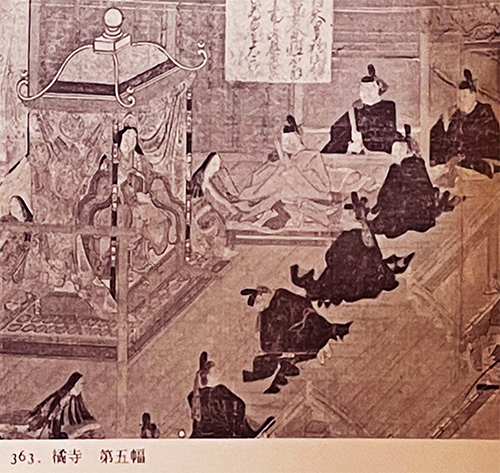


法隆寺宝物館「聖徳太子絵伝」記事、第16回目は推古天皇と聖徳太子による政権構造について。このシリーズの第一回はこちら→端正なモダニズム「法隆寺宝物館」探訪。
日本史が中国の歴史とも朝鮮半島の歴史とも大きく相違するのは、天皇という王権の存在。列島に統合的政治権力が発生して以来、国家統合の中核として存続してきた。
中国では易姓革命によって前王朝を暴力をもって倒した政権が変遷し続けてきた。朝鮮半島でもそもそも統一政権というものの方が稀有なように地域別に国家権力が乱立して権力が推移してきた。世界を見ても日本の権力構造はきわめて特殊で例外的な存在と言うことができるだろうと思う。辛うじてイギリスの権力構造が近似的だということがいえる。チャールズ国王の即位式で示された天皇家への配慮にはそういう意思が示されている。明治の大転換に際して、ヨーロッパ的な「皇帝型」権力というように転換したけれど、日本史の普通からすれば、明治以降戦前までの体制の方が特異的であって、むしろ敗戦後の占領軍統治以降の「象徴天皇制」の方がより普遍に近いと思える。敗戦後の混乱時、日本はギリギリの「国体護持」を計った様子がわかる。
そういった国体感覚の始原として聖徳太子の時代の権力構造が示唆的なのではないか。
写真は奈良で復元された平城京の「大極殿」のなかにある「高御座」。最近の令和の即位式でも今上天皇が座られたことが記憶に新しい。聖徳太子の時代でも太子22才の時に推古天皇が即位され、それと同時に「摂政」として聖徳太子が就任したことが「絵伝」に記録されている。
絵としての表現として、微妙な描き分けがあって面白い。2枚目の絵伝の図は法隆寺宝物館収蔵の皇室に寄贈された法隆寺本のもの。こちらでは、高御座に推古天皇が座られ、その脇に群臣とは高さを一段高くした座に聖徳太子が、やや体勢を「ナナメ」にして「殿上人」の群臣に対座されている。群臣たちはその位階に応じて高さの違う板敷きの間に座っている。そのなかから蘇我馬子がひとり進み出て天皇の詔勅を承っているところが描かれている。一方の「橘寺本」では同様の配置関係ながら、絵としては聖徳太子が正面に描かれている。構図に込められた意図の違いが興味をそそられる。
聖徳太子が摂政として国政を担当するに際しての事情が、奈良国立博物館での1965年の聖徳太子絵伝展の図録では以下のように解説(要旨)。
〜天皇は太子が摂政として政務を執ることを勅せられた。太子は身の不肖を理由に再三固持されたが、天皇はこれを容れられず、押して強く要望された。ここで太子は摂政となることを受諾した。民人はこれを聞いて慈父母に逢ったようだと悦んだという。〜
天皇自身が「三顧の礼」を尽くすというカタチで摂政権力・施政権への敬意を表すことで、いかにも「和を以て貴しとなす」ということを示されたのだろうか。いかにも倭国・和国。
English version⬇
Japanese Structure of Power: The Gallery of Horyuji Treasures-16
The creation of a national structure that separates kingship and government, where harmony is the key to nobility, from an imperial dictatorship and a system of vassal disputes within power. Is this the wisdom of the Japanese people? The wisdom of the Japanese people.
The 16th article in the “Shotoku Taishi E biography” series of the Gallery of Horyuji Treasures is about the structure of the government by Emperor Suiko and Shotoku Taishi.
What makes Japanese history so different from both Chinese history and Korean history is the existence of the royal power of the emperor. Since the emergence of unified political power in the archipelago, it has remained at the core of national unity.
In China, the Yi Surname Revolution led to the violent overthrow of the previous dynasty, and the regime has continued to change over the years. On the Korean Peninsula, too, unified government is a rarity. Looking at the rest of the world, Japan’s power structure can be said to be very unique and exceptional. The power structure of the United Kingdom is a close approximation. The consideration for the Emperor’s family shown at the coronation ceremony of King Charles indicates this intention. Although the Meiji Era brought about a major transition to a European-style “emperor-type” power, from the perspective of ordinary Japanese history, the system from the Meiji era to the prewar period was more unique, and the “symbolic emperor system” that emerged after the defeat of the Occupation forces in World War II is more universal. In the chaos that followed the defeat, we can see how Japan tried to “protect the national polity” at the very last minute.
The power structure of Prince Shotoku’s time may be suggestive as the origin of such a sense of national identity.
The photo shows the “High Imperial Throne” in the Daigoku-den Hall of Heijo-kyo, which was restored in Nara. It is fresh in our memories that Emperor Imagami sat in this seat at the recent accession ceremony of 2025. In the reign of Prince Shotoku, Emperor Suiko ascended to the throne at the age of 22, and at the same time, Shotoku Taishi assumed office as “regent,” as recorded in the “Pictorial Biography.
The second illustration in the pictorial biography is from the Horyuji version donated to the Imperial Household and housed in the Horyuji Treasury. In this painting, Emperor Suiko is seated on a high throne, flanked by Prince Shotoku, who is seated at a higher level than the courtiers, facing the courtiers, who are slightly “nana-mae” in their posture. The courtiers are seated on wooden floorboards of different heights according to their ranks. Among them, Soga no Umako is depicted as he steps forward to receive the emperor’s imperial decree. In the “Tachibana-ji” version, the same arrangement is used, but Prince Shotoku is depicted in the front. The difference in the intention behind the composition is intriguing.
The following is an explanation (abstract) of the circumstances surrounding Prince Shotoku’s assumption of national government as regent, as given in the catalogue of the 1965 exhibition of the pictorial biography of Prince Shotoku at the Nara National Museum.
〜The Emperor ordered that the Prince should administer the affairs of state as regent. The Prince repeatedly insisted on the appointment on the grounds that he was not worthy of the position, but the Emperor refused and insisted on the appointment. The Taishi accepted the request to become regent. When the people heard this, they rejoiced as if they had met a loving mother and father. ~ The Emperor himself said, “I will give you three blessings.
By showing his respect for the regent’s power and administrative authority in the form of the Emperor’s own “three-part courtesy,” was the Emperor demonstrating how “harmony is the key to nobility”? This is very Japanese and Japanese-style.
Posted on 6月 14th, 2023 by 三木 奎吾
Filed under: 歴史探訪







コメントを投稿
「※誹謗中傷や、悪意のある書き込み、営利目的などのコメントを防ぐために、投稿された全てのコメントは一時的に保留されますのでご了承ください。」
You must be logged in to post a comment.